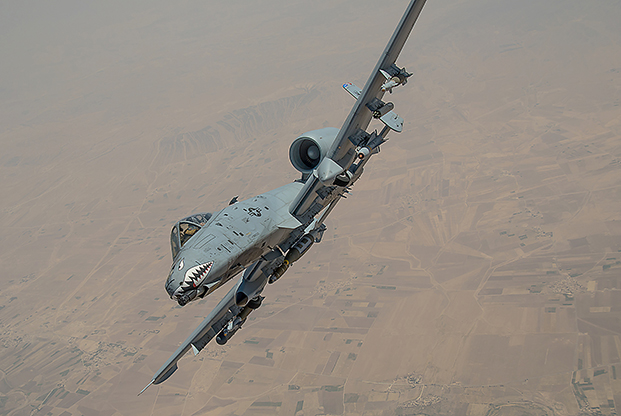
An A-10 with the 74th Expeditionary Fighter Squadron banks after refueling from a 22nd Expeditionary Air Refueling Squadron KC-135 during the fight for Raqqa, Syria. Photo: USAF
BIG DOINGS IN RAQQA
Before he deployed to Incirlik AB, Turkey, last summer, Capt. Brendan Lanphear’s longest sortie in the A-10 was four hours with one tanker refueling.
His first combat sortie, in support of the liberation of Raqqa, Syria, was more than seven hours long, involved fuel from four tankers, and marked the first time he employed weapons.
Every part of the 447th Air Expeditionary Group played a significant role in the battle, from the A-10s to the KC-135s to the maintainers, who made sure the aircraft stayed in the air and didn’t miss a single air tasking order sortie, said the unit’s commander, Col. Scott Hoffman.
Lanphear, a wingman deployed out of Moody AFB, Ga., with the 74th Expeditionary Fighter Squadron, wasn’t the only one facing a new situation in Raqqa.
In a recent phone interview with several representatives of the 447th AEG, Lt. Col. Craig Morash, commander of the 74th EFS, told Air Force Magazine that 20 pilots—a little more than half the squadron—were deploying for the first time. Even those with combat experience had never seen a battle like that.
“As A-10 guys, we train [for] nonlinear battles as well as linear battles, but urban conflict, at least in this form, [Raqqa] was kind of the first time anybody had ever seen it before,” Morash said.
He added that A-10 pilots generally train for two-hour sorties, but the sortie length when the squadron first arrived in-theater averaged 7.4 hours. Keeping the A-10s up in the air for so long required quite a lot of refueling, and the KC-135s of the 22nd Expeditionary Air Refueling Squadron (EARS), also part of the 447th AEG, did about a third of all the aerial refueling in support of Operation Inherent Resolve, Hoffman said.
The Warthogs dropped about 44 percent of the weapons in the Raqqa area for the first two-and-a-half months of the battle and more than half of those were danger close, Morash said—some as close as eight meters.
“Really, what I don’t think you can ever prepare for was the rate of expenditures that we were dropping or the dense urban conflict that Raqqa presented,” he said.
_
You can read this story in our print issue:
The Warthogs carried an extraordinarily diverse set of weapons, from 2,000-pound bunker busters, “which we dropped for the first time off an A-10 in Raqqa, to GPS weapons, laser-guided weapons, and precise low-collateral-damage weapons as well, to include laser rockets, the laser Maverick, and the versatile 30 mm,” he explained.
During a typical day of the fight for Raqqa, the KC-135s of the 22nd EARS, flew 13 to 15 sorties per day, averaging nearly six hours per mission and off-loading 60,000 pounds of fuel, said Lt. Col. Kelly Kimsey, director of operations for the 22nd.
In October 2017, the unit flew 296 missions and off-loaded 19.2 million pounds of fuel.
“The mission out here, the dynamic nature of it, is different than what we train for in the states,” Kimsey noted. “For a lot of our young crews that come out here, it’s the first time that they’ve seen, when they cross from Turkish airspace into the combat zone, how often the plan changes: the locations that they’re refueling, amounts of off-load, times, where they have to be. And it can be a little overwhelming for them … but they pick it up pretty quick, and by the time they’ve flown a sortie or two, it’s second nature.”
Kimsey said the crews stayed very focused on where the receivers wanted to be picked up and dropped off, to keep them as close to the fight as possible.
Morash added that the mission required the A-10s to “seek efficiency in everything that we did,” and they worked with both the tankers and the maintainers “to see how we could shave five minutes off refueling and get the jets turned that much faster, so that we could actually execute that length of mission that many times a day.”
Unlike the aircrews, the job for the airmen of the 447th Expeditionary Aircraft Maintenance Squadron (EAMXS) was not significantly different on deployment than at home station. Still, the deployment offered the opportunity to work on every aspect of the maintenance job, rather than focusing only on launching, fixing, or servicing, said Capt. Brett Gudim, 74th Aircraft Maintenance Unit officer in charge.
And, noted Lt. Col. Yoggi Lebby, commander of the 447th EAMXS, maintainers had the “opportunity to see jets come back without bombs loaded, the airplanes come back without bullets in the gun. … You’re actually getting to see all the things you’ve put in and effort come full circle.”
“It’s just astounding to me how rapidly over the course of this six months the work they have done has helped liberate so many people,” Hoffman said. “Even though I know my group here is small, we really … punched above our weight.”
_
Jennifer Hlad is a freelance journalist based in the Middle East and a former Air Force Magazine senior editor.